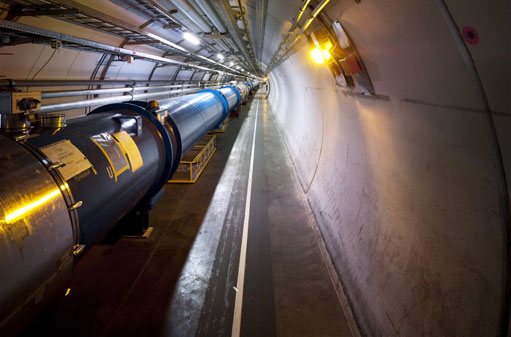
ATLAS e-News
23 February 2011
Accelerator on track
5 October 2009

Dipole with new valves (far left of frame, top of magnet). Courtesy of Maximilien Brice.
With more than a year’s worth of repairs and upgrades nearing completion, the Large Hadron Collider is almost ready to get down to business. Already, the magnets of each sector are getting down to their superconducting temperature of 1.9 K. And, even with a few unexpected challenges in the final stages of LHC repair and magnet preparation, the team is on track for a late-November start-up, as forecasted in July.
The accelerator group is finishing the installation of the upgraded quench protection system in seven sectors, sector 12 already completed. The system now detects quenches in the interconnects, the type of quench in last year’s incident. It also can identify an aperture-symmetric quench, which occurs in both sides of a magnet simultaneously – an unlikely quench that can be provoked, for example, by a quench in a neighbouring magnet.
All sectors have also received new pressure relief valves in the event that the upgraded quench system should fail. If fate tried to pull another Sept. 19th, these valves would allow the helium gas to escape into the tunnel before the pressure would push the magnets apart. Sectors 12, 34, 56, and 67 are safe up to the currents for 7 TeV beams, and the remaining sectors will receive the rest of their valves next shutdown.
In June and July, the accelerator group ran a Splice Copper Stabiliser measurement campaign. In the five warm sectors, any splice judged unsafe for 5 TeV beams was repaired. Already at 80 K, sectors 81, 78, and 23 could not be measured quite as accurately, but the accelerator group has determined that they are safe for running at 3.5 TeV.
According to Massimiliano Ferro-Luzzi, LHC Physics Coordinator, their safety for a 5 TeV run will be assessed, “after operational experience with beams, followed by detailed analysis, in particular of thermal and electrical behaviour during quenches that will inevitably occur during operation.”
Since July, most sectors have been busy finishing consolidation, cooling down, and running electrical tests. The Electrical Quality Assurance is particularly demanding, testing all circuits and connections. “It’s a checklist that has hundreds of steps, to get a sector ready for powering,” says Dr Ferro-Luzzi. Sectors 12, 78, and 56 are already undergoing powering tests up to 3.5 TeV, the initial level for the LHC’s first run next year, with the rest of the sectors to follow.
According to July’s plan, sector 67 would be running power tests as well. However, a cable segment, designed to keep the cable interconnections between magnets from breaking as the LHC materials contract during cooling, touched another part of the magnet, creating a short circuit. The fault was readily detected by the monitoring system. While there was no serious damage to the magnet, the four-week delay was enough to make sector 67 last to cool.
The schedule absorbed most of this “lost time”. It resulted in a total of three days’ delay, which is "in the noise of the overall schedule", as Dr Ferro-Luzzi says, "since we can't be certain of the LHC schedule to that level of accuracy".
The first injection tests are set for later this month, from Saturday to Sunday, October 24-25. Around November 13th, machine checkout is set to begin, making sure that all systems are go for a 450 GeV beam to travel through, one week later. In early December, we can look forward to the LHC’s baby steps and our first collision data at 450 GeV.
After just two days of test collisions, the plan is to ramp up to 3.5 TeV over about two weeks, culminating three brief but exciting days of collisions before the winter holiday.
Of course, all these dates are “best guesses”, as Dr Ferro-Luzzi put it. For 2010, as things stand, we should see beam commissioning through most of January and the beginning of February, and a 3.5 TeV run from early February to early May. Ramping up to 5 TeV through May, a higher-energy run is scheduled from early June through mid-October, with a month’s worth of ions in November.
Starting out with a few largely spaced bunches in the rings, more than 500 nanoseconds apart, the accelerator team won't add the complication of a crossing angle until they are ready to take the beam intensity up. The more intense beams will contain many more bunches, reducing bunch spacing to 50 ns. The shorter distance between bunches will require a crossing angle, in order to avoid multiple interaction points.
The crossing angle will be introduced in June, according to the estimated schedule, allowing the integrated luminosity to press on toward few hundred inverse picobarns into the autumn. "The proposed plan for intensity increase and beam squeezing give you a flavour of how we will try to push the luminosity up, but certainly we don't know if it will go this way or not,” Dr Ferro-Luzzi reminds.
Whether beams will be brought all the way up to 5 TeV, and at what moment, is still undecided. “Experience with 3.5 TeV will drive this decision,” says Dr Ferro-Luzzi. Many milestones lie between now and the day that decision is taken. But in this stage, the accelerator group is humming along toward the next start-up.

Katie McAlpineATLAS e-News |